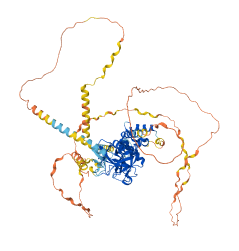B1AYC9
Gene name |
Apbb1ip |
Protein name |
Amyloid beta A4 precursor protein-binding family B member 1-interacting protein |
Names |
APBB1-interacting protein 1 |
Species |
Mus musculus (Mouse) |
KEGG Pathway |
mmu:54519 |
EC number |
|
Protein Class |
GROWTH FACTOR RECEPTOR-BOUND PROTEIN (PTHR11243) |

Descriptions
RIAM is a multidomain scaffold protein that is regulated by recruitment from the cytosol to the plasma membrane. RIAM is autoinhibited by an intramolecular interaction between the inhibitory segment (IN) region and the RAS-association (RA) region, which inhibits its association with RAP1. Phosphorylation of Tyr45 in the IN segment by focal adhesion kinase (FAK) releases this autoinhibition, facilitating translocation to the plasma membrane and enhancing integrin-mediated cell adhesion.
Autoinhibitory domains (AIDs)
Target domain |
179-266 (RAS-association, RA) |
Relief mechanism |
PTM |
Assay |
Deletion assay, Mutagenesis experiment, Structural analysis |
Accessory elements
No accessory elements
Autoinhibited structure
Activated structure

2 structures for B1AYC9
| Entry ID | Method | Resolution | Chain | Position | Source |
|---|---|---|---|---|---|
| 6E31 | X-ray | 240 A | A | 27-437 | PDB |
| AF-B1AYC9-F1 | Predicted | AlphaFoldDB |
No variants for B1AYC9
| Variant ID(s) | Position | Change | Description | Diseaes Association | Provenance |
|---|---|---|---|---|---|
| No variants for B1AYC9 | |||||
No associated diseases with B1AYC9
Functions
| Description | ||
|---|---|---|
| EC Number | ||
| Subcellular Localization |
|
|
| PANTHER Family | PTHR11243 | GROWTH FACTOR RECEPTOR-BOUND PROTEIN |
| PANTHER Subfamily | PTHR11243:SF14 | AMYLOID BETA A4 PRECURSOR PROTEIN-BINDING FAMILY B MEMBER 1-INTERACTING PROTEIN |
| PANTHER Protein Class | scaffold/adaptor protein | |
| PANTHER Pathway Category | No pathway information available | |
2 GO annotations of cellular component
| Name | Definition |
|---|---|
| cytosol | The part of the cytoplasm that does not contain organelles but which does contain other particulate matter, such as protein complexes. |
| plasma membrane | The membrane surrounding a cell that separates the cell from its external environment. It consists of a phospholipid bilayer and associated proteins. |
No GO annotations of molecular function
| Name | Definition |
|---|---|
| No GO annotations for molecular function |
1 GO annotations of biological process
| Name | Definition |
|---|---|
| signal transduction | The cellular process in which a signal is conveyed to trigger a change in the activity or state of a cell. Signal transduction begins with reception of a signal (e.g. a ligand binding to a receptor or receptor activation by a stimulus such as light), or for signal transduction in the absence of ligand, signal-withdrawal or the activity of a constitutively active receptor. Signal transduction ends with regulation of a downstream cellular process, e.g. regulation of transcription or regulation of a metabolic process. Signal transduction covers signaling from receptors located on the surface of the cell and signaling via molecules located within the cell. For signaling between cells, signal transduction is restricted to events at and within the receiving cell. |
No homologous proteins in AiPD
| UniProt AC | Gene Name | Protein Name | Species | Evidence Code |
|---|---|---|---|---|
| No homologous proteins | ||||
| 10 | 20 | 30 | 40 | 50 | 60 |
| MGESNEDIDQ | MFSTLLGEMD | LLTQSLGVDT | LPPPDPNPPR | EEFNYTVGFK | DLNESLNALE |
| 70 | 80 | 90 | 100 | 110 | 120 |
| DQDLDALMAD | LVADISEAEQ | RTIQAQKESS | QNQDRFALLR | ASDGQGTASG | GYGASAAAID |
| 130 | 140 | 150 | 160 | 170 | 180 |
| VSHHEEALPP | PPVEPMLDLL | PPPPPPPPPE | LLSKEEEEAK | AKADKIKLAL | EKLKEAKVKK |
| 190 | 200 | 210 | 220 | 230 | 240 |
| LVVKVHMDDS | STKSLMVDER | QLARDVLDNL | FEKTHCDCNV | DWCLYEIYPE | LQIERVFEDH |
| 250 | 260 | 270 | 280 | 290 | 300 |
| ENVVEVLSDW | TRDTENKVLF | LEKEERYAVF | KNPQNFYLDN | KGKKENKETN | EKMNAKNKEY |
| 310 | 320 | 330 | 340 | 350 | 360 |
| LLEESFCGTS | IIVPELEGAL | YLKEDGKKSW | KRRYFLLRAS | GIYYVPKGKT | KTSRDLACFI |
| 370 | 380 | 390 | 400 | 410 | 420 |
| QFENVNIYYG | IQCKMKYKAP | TDHCFVLKHP | QIQKESQYIK | YLCCDDARTL | SQWVMGIRIA |
| 430 | 440 | 450 | 460 | 470 | 480 |
| KYGKTLYDNY | QRAVARAGLA | SRWTNLGTVG | TPMPAQPSTV | SSGLKTGTSQ | PNGQMPQAIP |
| 490 | 500 | 510 | 520 | 530 | 540 |
| SAGPPLQEAQ | TQIETTKDEK | QGLGNHSPGA | TRENHRPKSS | LPPPPPPVRR | SSDTCGSPAL |
| 550 | 560 | 570 | 580 | 590 | 600 |
| PSKVKGPGTC | TFPHPPENFL | PPPPPPPPEE | DNSGLLPPPP | PPPYLEEPPD | FVPPPPPPAA |
| 610 | 620 | 630 | 640 | 650 | 660 |
| VEDSALPPPP | PPPPCLSQEI | TKSSPLPPKK | PLVPPKRQEN | QGLPGAPGNS | EQDFMSDLMK |
| ALQKKRGNIP |